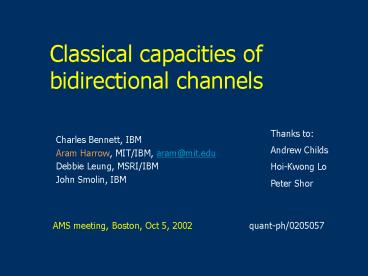Classical capacities of bidirectional channels - PowerPoint PPT Presentation
Title:
Classical capacities of bidirectional channels
Description:
Classical capacities of bidirectional channels Thanks to: Andrew Childs Hoi-Kwong Lo Peter Shor Charles Bennett, IBM Aram Harrow, MIT/IBM, aram_at_mit.edu – PowerPoint PPT presentation
Number of Views:32
Avg rating:3.0/5.0
Title: Classical capacities of bidirectional channels
1
Classical capacities of bidirectional channels
Thanks to Andrew Childs Hoi-Kwong Lo Peter Shor
- Charles Bennett, IBM
- Aram Harrow, MIT/IBM, aram_at_mit.edu
- Debbie Leung, MSRI/IBM
- John Smolin, IBM
AMS meeting, Boston, Oct 5, 2002
quant-ph/0205057
2
Outline
- Background bidirectional channel capacities and
mutual information. - Example.
- Main result determining the entanglement-assisted
one-way capacity. - Upper bound.
- Remote state preparation and a protocol for
achieving the capacity. - Plenty of open questions
3
One-way channels
A channel can achieve a rate R if n uses of the
channel can transmit n(R-dn) bits with error en,
where dn,en!0 as n!1.
The (classical) capacity is the largest rate
achievable by the channel.
4
Bidirectional Channels
- A pair of rates (RÃ,R!) is achievable if n uses
of the channel can transmit ¼nRÃ bits from Bob to
Alice and ¼nR! bits from Alice to Bob.
Result A zoo of different capacities.
Our approach Specialize to entanglement-assisted
one-way capacity.
5
Mutual Information c
- For an ensemble Epi, si, the mutual
information is
For pure states Epi, yiiAB, we use Bobs
reduced density matrix.
6
Example CNOT Hamiltonian
Applying H for time t yields the unitary gate
Ue-iHt.
Goal Send the maximum number of bits from Alice
to Bob per unit time.
7
Example protocols 1/2
- Alice begins with either 0i or 1i.
- Bob begins with 0i.
- After time t, Bob has either 0i or cos t0i
sin t1i.
- The ensemble is
- The mutual information is c(Et) H2(sin2t),
where H2(p)-plog2p-(1-p)log2(1-p).
8
Example protocols 2/2
9
What wed like to do
- Create n copies of the optimal ensemble E.
- Apply N to each copy.
- Measure, obtaining mutual information nc(N(E)).
- Use nc(E) bits to recreate n copies of E and keep
the remaining n(c(N(E))-c(E)) bits as message. - Return to step 2 and repeat.
Asymptotically c(N(E))-c(E) bits per use of N.
10
General result
Theorem
In English
With free entanglement, the asymptotic capacity
of a bidirectional channel N is equal to the
maximum increase in mutual information from a
single use of N.
11
Upper bound
Claim n uses of N can increase c by no more
than nsupE c(N(E))-c(E).
Proof The most general n-use protocol looks
like
Local operations can never increase c.
12
Relating c to classical bits
(Block coding) For large n, En can encode ¼nc(E)
bits.
(Weak converse) If a measurement on E yields
classical mutual information I between outcomes
and encoding, then Ic.
(Strong converse) With free entanglement, En can
be prepared by transmitting ¼nc(E) bits.
13
Remote State Preparation
- Given large amounts of shared entanglement, Alice
chooses a state to transmit, makes a measurement
and sends the classical result to Bob, from which
he can reconstruct the state.
- 1 cbit many ebits ! 1 qubit
- (Bennett et al., PRA 87 (2001) 077902)
- If Epi, yiiB, then Alice can Schumacher
compress E and send only S(E) cbits.
- With mixed-state RSP, Epi, yiiAB can be
sent using c(E) cbits and free entanglement. - (Shor, unpublished, 2001)
14
Achieving the bound (proof)
- Alice breaks up her message into strings M1,,Mk,
each of length n(c(N(E))-c(E)). - She will recursively determine strings R1,,Rk,
each of length nc(N(E)) from RSP measurements. - First let Rk be an arbitrary string.
- For ik, k-1, , 3, 2 choose fii2En such that
N n(fiihfi) encodes (Mi, Ri). - Perform the RSP measurement for fii to obtain
Ri-1. - Send (M1, R1) inefficiently, with O(n) uses of N.
- For i2k
- Bob uses Ri-1 to construct fii.
- They apply Nn to fii.
- Bob measures N n(fiihfi) to obtain (Mi, Ri).
15
Achieving the bound (Bob)
16
Achieving the bound (Alice)
17
More open questions than results
- For entanglement-assisted communication, how many
elements are in the optimal ensemble? What
dimension ancilla are necessary? Can we ever
determine the optimal ensemble exactly?
- How are communication capacities related to
entanglement generating rates?
- How do forward and backward capacities trade off
with one another? Are they ever asymmetric for
unitary gates? How does entanglement affect
this?
- Can we define a bidirectional mutual information?
Or bidirectional remote state preparation?
18
Symmetry?
Two qubit gate capacities are always locally
equivalent to symmetric gates due to the
decomposition
For dgt2, no such decomposition exists, and there
may be asymmetric gates.
19
Asymmetric capacities?
Define a gate U acting on a dd dimensional space
by
- The forward capacity is at least log d, but the
backward capacity is thought to be less than log
d. - With free entanglement, the backwards capacity is
also log d. - For one use without entanglement, the backwards
mutual information is provably less than log d.































